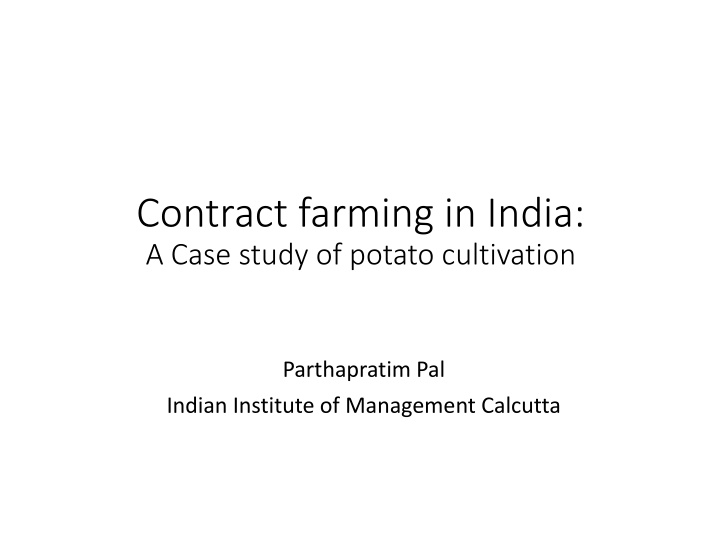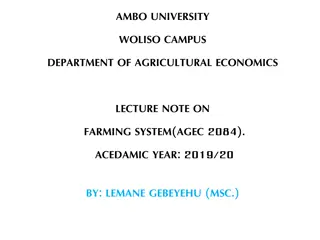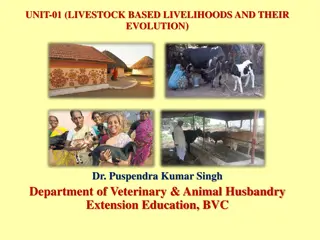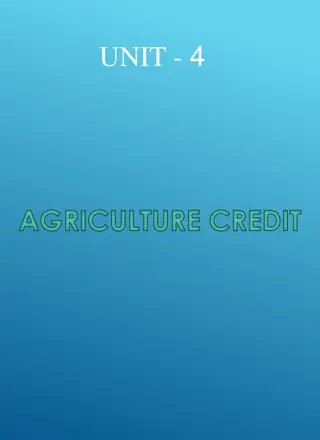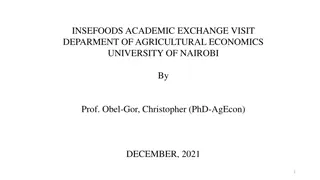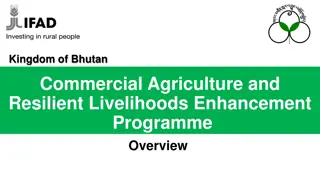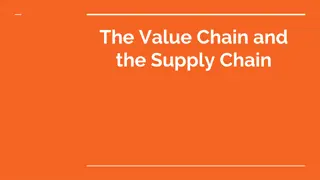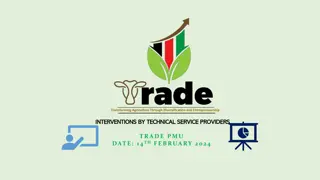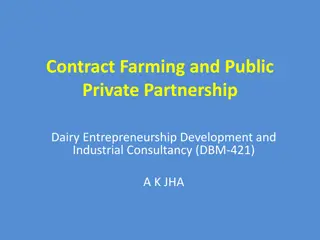Contract Farming in India: Enhancing Agricultural Value Chain Through Partnerships
Value addition in Indian agriculture has been low due to limited processing levels. Contract farming is emerging as a viable solution to integrate agriculture production into the global value chain, albeit with concerns about unequal bargaining power. Various forms of contract farming exist, with examples from companies like ITC Limited, Nestle India, and Pepsico India. Additionally, contract farming is being explored as a Corporate Social Responsibility (CSR) initiative, as seen in Project Unnati aiming to promote Ultra High Density Plantation farming practices in collaboration with Jain Irrigation and Coca-Cola.
Download Presentation

Please find below an Image/Link to download the presentation.
The content on the website is provided AS IS for your information and personal use only. It may not be sold, licensed, or shared on other websites without obtaining consent from the author.If you encounter any issues during the download, it is possible that the publisher has removed the file from their server.
You are allowed to download the files provided on this website for personal or commercial use, subject to the condition that they are used lawfully. All files are the property of their respective owners.
The content on the website is provided AS IS for your information and personal use only. It may not be sold, licensed, or shared on other websites without obtaining consent from the author.
E N D
Presentation Transcript
Contract farming in India: A Case study of potato cultivation Parthapratim Pal Indian Institute of Management Calcutta
Background Value addition in Indian agriculture has been low as the level of processing in this sector has been poor Ghosh, Bhandari and Sharma (2013) show extent of processing in Indian fruits and vegetables to be 1.7 percent and 2.4 percent respectively Share of processing in advanced developing countries in these sectors vary between 30 to 50 percent. These shares are even higher for developed countries.
Contract Farming in India To improve value addition it is suggested that it is important to link agriculture production with the complete agriculture value chain Contract farming is seen as a possible way of integration in the global value chain Domestic and foreign companies are gradually getting into contract farming and sourcing more agricultural products from India This has raised the question whether the unequal bargaining power between domestic farmers and large corporates will lead to exploitation of farmers
Contract Farming in India Contract farming can take various forms: procurement contracts under which only sale and purchase conditions are specified; partial contracts wherein only some of the inputs are supplied by the contracting firm and produce is bought at pre-agreed prices; and total contracts under which the contracting firm supplies and manages all the inputs on the farm and the farmer becomes just a supplier of land and labour. Examples: ITC Limited and tobacco growers in Andhra Pradesh Nestle India and dairy farmers in Punjab Pepsico India and potato growers in Gujarat, Karnataka and West Bengal Pepsico India s experiment with tomato growers in Punjab, ITC Limited s arrangement with vegetable growers in Punjab In India, most contract farming arrangements are not backed by formal contract agreements. These are implicit trading arrangements between the buyer and the seller.
Contract Farming as CSR From the Project Unnati website: Project Unnati set to be a key milestone towards the large scale adoption of Ultra High Density farming Practice (UDHP) leveraging drip irrigation Introduction of Ultra High Density Plantation will double the average mango yields Project Unnati has the potential to improve the livelihoods of more than 50,000 farmers in the next five years Farms under Project Unnati will also be used to showcase and train farmers on Ultra High Density Plantation under a joint capability building program led by Jain Irrigation and Coca-Cola University Project Unnati is a collaborative effort of Coca-Cola with Jain Irrigation to build a sustainable supply chain for Coke's mango beverage, Maaza. The program offers financial support and imparts training on Ultra High Density Plantation, a modern farming technique.
Some Preliminary Observations about contract farming To understand how contract farming works we carried out a survey of potato farmers in West Bengal and Gujarat In West Bengal potato farmers we surveyed are either contract farmers for Pepsico or they were doing non-contract farming Both types of farming are being done almost side by side. Some farmers even do both contract and non-contract farming In one of the regions surveyed, smaller farmers seemed more keen on contract farming than the medium farmers In Gujarat we studied some large farmers who are contract farmers for an Indian company- Balaji Group
Why only some farmers are interested in contract farming while others are not? This study tries to understand the decision making process followed by the farmers of potato in presence of two different cultivation models The prevailing farming model The so-called contract/contact/collaborative farming model. In a way, the decision making process is similar to economic models where an economic agent chooses between two outcomes: a risky but more rewarding one and one with lesser risk and lesser reward
Some features of the prevailing system of potato farming in West Bengal: Traditional potato farming in West Bengal suffers from a number of problems and uncertainties: Quality of seeds Timely availability of seeds Issues related to rural credit Lack of extension services from the government. This seems to be a major problem in the areas we visited. High use of chemical fertilisers- soil degradation High variability of the post harvest price No MSP in potato Storage related problems
Some features of the contract farming1 Farmers are offered a pre-determined price before the farming season This offered price is based on the quality of the output. In case of potato, potatoes of a standard size gets a higher price. Potatoes which do not conform to that standard receive a lower price or they are not taken by Pepsi The inputs are provided by the contracting firm as credit. However, longer term fixed capital loans and consumption loans are outside the deal. The inputs are more organic in nature compared to the traditional farming. It is possibly for meeting domestic and international food standards
Some features of the contract farming2 Potatoes cultivated are not of the table variety. Atlanta is the most used variety of potato. This variety does not have a local market due to its different taste. Irrigation and plantation techniques are different in contract farming. They are aimed more towards achieving the right size and quality of the product. Extension services are provided by the contracting firm Inputs and extension services are provided through a local nodal farmer who also acts as an aggregator Farmers get a payment based on the net amount receivable to them at the end of the season Farmgate collection of output is done.
Some features of the contract farming3 Due to differences in potato variety, plantation technique, fertilisers used and irrigation technique output per unit of land is lower in contract farming (6:5 ratio) But the potatoes are of better quality and more uniform size. The emphasis is on meeting specifications for mechanized production of chips and food standards. Last year Pepsi offered rates of Rs 850/q for good potatoes and about 400 Rs/q for bad sized potatoes. In some regions, bad sized potatoes were totally rejected. Bad size potato ratio can be between 10 percent to 30 percent. The rejection rates vary quite widely from year to year and from region to region. Farmers cannot sell the rejected Atlanta potatoes in the local market. They mix it with table varieties to sell
For regular cultivators The post harvest price can be highly volatile and can move between 500Rs/q to 2000 Rs/q over the next 7-8 months For the traditional farmer, the price that he receives from selling his product is uncertain. It can be a function of various things including time, total supply, supply in other states, other demand-supply issues and speculative factors. The rate of interest from village moneylenders may vary between farmers but the modal value is around 10 percent for the potato cropping season (November to March)
The profit function of the Contract farmer ??????? ? ? ??????????? ?? ??????? ? ? ?????? ?? ? ? ????????? ??????? ?? ?? ? ?? ? ? ????????? ?? ??????? ?????? ?? ? ? ??? ???????? ???? ?? 1 ?? ??? ?1 ??? ?2 ?? ? ? ????? ???? ?? ???????? ?? ? ? ????????? ??????? ?? ? ? ????? ???? ?? ?? ???????? ?? ? ? ??? ????????? ???????, P2*<< P1* We also assume the producer will incur the following costs: A cost Dwas a working capital loan A cost Dkas fixed capital loan Therefore, the expected profit function of the contract farmer is .? ? + (1 ??).?2 .? ? ?? ?? ? ??= ??.?1 Where f(Q) is the production function for contract farming
Profit function of the standard potato farmer For the traditional farmer, the price that he receives from selling his product is uncertain. It can be a function of various things including time, total supply, supply in other states, other demand-supply issues and speculative factors. For simplicity, we assume that the expected price received by the farmer is a function of time. So the expected price by the traditional former is p(t) So the expected profit function for the traditional farmer is ? ??= ? ? .? ? ???1 + ?? ???1 + ?? Where g(Q) is the production function. Dtwand Dtkare the working capital and fixed capital loans respectively. And r is the rate of interest charged on those loans. t= time of sale.
The choice facing the farmers1 The expected profit functions facing the farmers are: ? ??= ? ? .? ? ???1 + ?? ???1 + ?? ? ??= ??.?1 .? ? + (1 ??).?2 .? ? ?? ?? A farmer will opt for contract farming if ? ??> ? ?? Let us assume that fixed capital loans are same for both the types of farming. These are outside the contract with the MNC but the payment period may be different.
The decision making process: .? ? + (1 ??).?2 .? ? ?? ? ? .? ? ???1 + ?? ??.?1 Green=known Amber=estimated Red=unsure/less known As seen above, the decision making involves a number of estimated variables each with some stochastic possibilities For a small farmer it becomes difficult to play the market and take advantage of the higher prices in the later months. It also implies higher debt burden. Therefore, a smaller or a more risk averse farmer may adopt contract farming However, a farmer who can play the market better or is not a risk averse agent, may gain if they go for traditional farming. This explains the observed phenomena in West Bengal that contract farming is not very popular
Some concluding observations1 The contract farming model does not bring in many new innovations. It is a combination of: Supply of input credit Supply of quality inputs Provisions of extension services An assured price Farmgate collection of output By providing these services, it is allowing the corporates to get a steady and quality supply of inputs But are the prices received by the farmers fair prices ?
Some concluding observations We interviewed a much bigger potato farmers in Gujarat and they receive much higher price for his contracted output. He supplies to the Balaji group and receives around 40% higher prices than what Pepsi offers to farmers in WB. In West Bengal, contract farming is a Monopsony market and the farmers can get a better deal if they negotiate as a group
Possible Group formations Formation of producers groups can Improve bargaining power among small farmers Give them some benefits of scale Move from a largely intermediary driven process to producer driven process Present Thrust: Formation of Farmer-Producers Organizations (FPOs) Encouragement for emergence of so-called Social-Entrepreneurs Lack of knowledge about these initiatives and low trust levels among rural population after the chit fund scam is affecting their growth in WB. These are new initiatives and it is an open question whether FPOs and Social Entrepreneurs will be able to reduce the uneven bargaining power in this sector. Unless that happens higher processing may not result in overall improvement of agriculture.
Thank you Feedbacks are most welcome parthapal@iimcal.ac.in
FPOs: the current favourite The Agriculture Ministry has proposed amendments to the NCDC Act to include farmer producer organisations (FPOs) for extending financial assistance and government subsidies. The government is encouraging setting up of FPOs in a big way and trying to provide credit facilities through various schemes so that FPOs become viable. FPOs, which are registered under the Companies Act, are firms consisting of small and marginal farmers. There are total 300 FPOs in India supported by government body Small Farmers Agribusiness Consortium (SFAC). Financial assistance is being given for production, processing, marketing, storage, export and import of agricultural produce and other notified commodities.
Estimation by the farmers of the unknown variables1 .? ? + (1 ??).?2 .? ? ?? ? ? .? ? ???1 + ?? ??.?1 From our case studies we found that The expected values of the production functions are estimated based on past experiences. It appears to follow an adaptive expectation type adjustment pattern. Given the same unit of land, the ratio of output between g(Q) and f(Q) is 6:5. The traditional production function produce marginally more output but the potato sizes are more standardized in the contract farming production function Bad size potato ratio in f(Q) can be between 10 percent to 30 percent. The rejection rates vary quite widely from year to year.
The choice facing the farmers2 The updated expected profit functions facing the farmers are: ? ??= ? ? .? ? ???1 + ?? ? ??= ??.?1 .? ? + (1 ??).?2 .? ? ?? A farmer will opt for contract farming if ??.?1 .? ? + (1 ??).?2 .? ? ?? ? ? .? ? ???1 + ?? Known variables in this equation are: ?1 , ?2 , r Last year Pepsi offered rates of Rs 850/100 Kg for good potatoes and about 400 Rs/100 Kgs for bad sized potatoes The rate of interest may vary between farmers but the modal value is around 10 percent for the potato cropping season (November to March)
Contract (Contact) farming in West Bengal Contract farming is formally not allowed in West Bengal- such contracts are not legally enforceable However, a number of companies, including Pepsi is getting into informal/semi- formal contracts with farmers to secure supply for their retail products. Pailan group and Mcain are other major players. To avoid legal hassles Pepsi calls it contact farming or collaborative farming . Pepsi is active in West Bengal, as it is in some other states, in collaborative farming. According to its website: PepsiCo works with around 24,000 farmers across nine states under collaborative farming model, procures around 45 per cent of its current total requirement of 2.40 lakh tonnes of potato per annum by working with farmers and the rest 55 per cent from the open market. Pepsi intends to scale up this process and procure 65 per cent of its requirements directly from the farmers in two years time.
Estimation by the farmers of the unknown variables2 .? ? + (1 ??).?2 .? ? ?? ? ? .? ? ???1 + ?? ??.?1 The most difficult element to predict is the expected price The post harvest price can be highly volatile and can move between 500Rs/q to 2000 Rs/q over the next 7-8 months It is mostly a function of demand supply imbalance/balance but can also have a strong speculative element in it Storing potatoes in cold storage has its own problems. There are weight loss, spoilage and cold storage charges. But the farmers and traders have a good estimate about these costs There is a huge informal/semi formal potato bond market in West Bengal for hedging risks. This market is largely dominated by the traders and larger farmers
